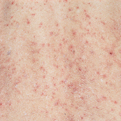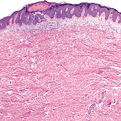Grover Disease
General Information
Grover Disease or Transient Acantholytic Dermatosis (TAD) is characterized by papules and papulovesicles with excoriation occurring on the chest, back, lower sternum, arms, and thighs. Often starting quite suddenly and is more common in the winter than in the summer. Although, frequently itchy it may cause no symptoms. The spots may be blistered, crusted, or eroded and there may be some bleeding. The most important step in the treatment of Grover’s disease is to remain cool, as further sweating will induce more itchy spots. Minor outbreaks can be controlled with prescription strength topical cortisone creams. More troubling eruptions usually clear up after taking Accutane or Tetracycline pills for one to three months. If these fail or the outbreak is severe, PUVA phototherapy treatments, antifungal pills and cortisone injections are alternatives.
Epidemiology
Mainly seen in males over the age of forty
Etiology
Unknown, the most frequent associations is heat or sweating, and the obstruction of sweat ducts has been suggested to be responsible.
Pathogenesis
Clinical
Small red, bumpy spots (papules) on the central back, mid chest and occasionally elsewhere. Spots may be blistered, crusted or eroded. There may be slight bleeding
Histology
Characteristic appearance with acantholysis (separated skin cells) with or without dyskeratosis (abnormal rounded skin cells).
Bibliography
1. “Grover Disease” (Online) July, 2006. http://www.thedoctorsdoctor.com/diseases/grovers_disease (visited: March 12, 2008) 2. “Grover’s Disease” (Online) November 2007. http://dermnetnz.org/scaly/grovers.html (visited: March 12, 2008)
Download PDF
![]() Grover Disease
Grover Disease


